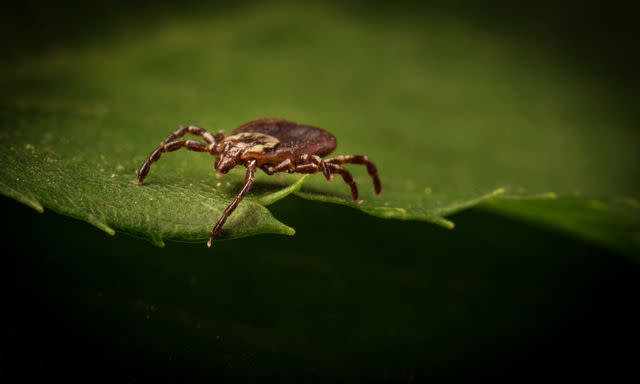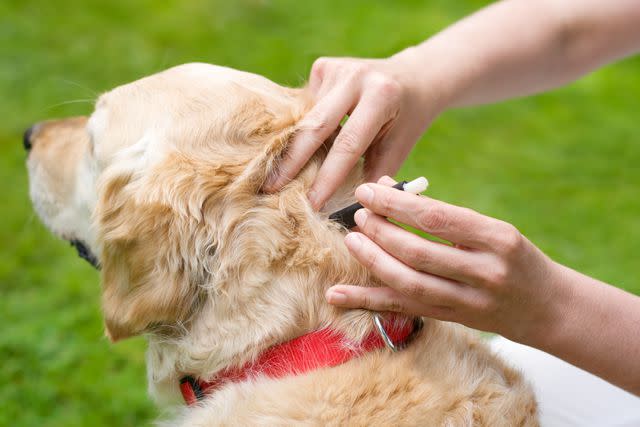How To Get Rid Of And Prevent Ticks, According To An Expert
Here’s how to keep these parasites away from you and your pets.
Whether you’re hiking, picnicking, or working in your garden, ticks are a year-round risk in the South. These blood suckers find a host by sensing odors, heat, vibrations, and shadows or by “questing” on the tips of grasses with their front legs extended—waiting for a person or animal to brush by them.
Once ticks sense a host is near, they scramble onto their victims. “Ticks can’t fly or jump, but they grab onto your clothes or your pet’s fur and then start searching for a place to embed,” says Eric Benson, PhD, professor emeritus and extension entomologist at Clemson University. “They wander around until they find a good spot to attach, but you often don’t feel them.”
Meet The Expert
Eric Benson, PhD, is professor emeritus and extension entomologist at Clemson University.
Although not every tick carries disease, some can transmit illnesses such as Lyme disease, Rocky Mountain spotted fever, and southern tick-associated rash illness, or STARI, says Benson. Although the data isn’t conclusive, researchers believe it takes some time for an infected tick to vector, or transmit, the pathogens. That means the sooner you can remove a tick that’s attached to you or your pet, the better.
Ahead, here’s what else you need to know about how to get rid of ticks:

Getty Images
Types Of Ticks
There are many different species, but Benson says the most common types of ticks in the South include:
· Lone star tick (Amblyomma americanum) with the adult female having a single white dot in the center of a brown body. These are the most abundant type in the Southeast.
· Black-legged tick (Ixodes scapularis), or deer tick, which is reddish-brown
· American dog tick (Dermacentor variabilis), which is brown with whitish-gray markings
· Brown dog tick (Rhipicephalus sanguineus), which can infest homes and dog kennels. They can spend their entire life cycle indoors, though they’re less likely to bite humans than other types of ticks.
Related: How To Keep Mosquitoes Away
Common Tickborne Diseases
Not every tick is infected with pathogens, says Benson. But in the Southeast, the most common illnesses they transmit to people and pets are:
· Lyme disease, which is transmitted by ticks such as the deer tick. The characteristic rash may appear at the site of the bite. Other symptoms include fever, headache, chills, and muscle aches. Untreated, it may lead to chronic medical problems that may be misdiagnosed as arthritis.
· Rocky Mountain spotted fever (RMSF) is spread to humans by the American dog tick. Symptoms include sudden onset of fever, headache and muscle pain with a spotty rash. This disease can be fatal if not treated early.
· Southern tick-associated rash illness (STARI) is transmitted by lone star ticks; it has a rash similar to Lyme disease as well as symptoms such as fatigue, fever and headache.
· Ehrlichiosis can be transmitted by different kinds of ticks including the lone star tick. Symptoms include fever, headache, joint pain, nausea and vomiting. If left untreated, long-term health issues may occur.
If you suspect you’ve been bitten by a tick, consult your doctor as soon as possible. Or if you find one attached and want to have it identified accurately, remove it (see below how to do it properly) and preserve it by keeping it in zippered-top plastic bag with a damp paper towel, says Benson.
Tick Prevention For People And Pets
It’s impossible to avoid ticks altogether, but you can take a few steps to protect yourself and your pets, says Benson.
· Avoid wooded and brushy areas with high grass, when possible. Walk in the center of trails, and avoid sitting on rotten logs or stumps, where ticks shelter.
· If you must be in a brushy area, wear long sleeves and pants, and tuck pant legs into socks and boots. Wear closed toe shoes and hats. Light-colored clothing makes it easier to see ticks, too.
· Treat clothing with products containing 0.5 percent permethrin. Permethrin can be used on boots, clothing and camping gear and will last through several washings.
· Wear EPA-registered insect repellants that contain DEET, picaridin, or IR3535. Read the label to see how often you need to reapply.
· Ask your vet about oral medications, impregnated collars, or topical treatments for pets. These pet products should be used year-round in the South.
· Do a tick check on yourself and pets as soon as you come indoors. Search in bends and folds of skin in areas such as the scalp, in and around the ears, under arms and behind knees, inside the belly button, around the waistline, and between fingers and toes. For pets, inspect their entire bodies, especially around the ears, eyes, armpits, tail and toes.
· Shower immediately. This can remove any ticks that haven’t attached yet. Clothing should be washed and tumbled dry on high for at least 30 minutes.

Getty Images
Tick Removal Techniques
Ticks can range in size from a poppy seed to a watermelon seed, especially if engorged with blood. If you find a tick on yourself or pet, don’t panic! Be methodical and follow these steps:
· Remove the tick as quickly as possible. Use fine-tipped tweezers or a tick removal tool to grasp it as close as you can to the skin. Avoid using folklore methods that do not work, such as nail polish remover, matches, or petroleum jelly.
· Pull upward with steady, even pressure. Don’t squeeze! You’ll need to pull harder than you expect, but try not to twist or jerk it because the mouthparts can break off and be left behind. If anything remains, try to pull it out with tweezers. Or leave it alone and let the skin heal.
· Clean the bite area and your hands with soap and water. Save the tick in a sealed bag or container, if you want to ID it.
· Call your doctor if you develop a rash or symptoms such as fever within a few weeks of removing a tick.
Related: How To Keep Spiders Away, According To Experts
For more Southern Living news, make sure to sign up for our newsletter!
Read the original article on Southern Living.

